Fastnet Race: A review of the 90th Anniversary
Published on August 24th, 2015
The Rolex Fastnet Race, the event that caused the formation of the Royal Ocean Racing Club, celebrated its 90th birthday in 2015.
How the founding fathers of the club and its flagship event would have been in awe of their creation with 300 boats signing up within just 24 minutes of the entry list opening in January, a record-sized fleet of 356 boats starting from the Royal Yacht Squadron line making the Rolex Fastnet Race by far the largest of the world’s classic 600 mile offshore races, in terms of participation.
It attracts top teams from around the world with boats ranging from Spindrift 2 and Comanche – the world’s fastest offshore racing multihull and monohull respectively – down to Contessa and Dehler 32 cruiser racers with every conceivable flavour of offshore racing yacht in between.
The upper echelons in the fleet are packed with America’s Cup and Volvo Ocean Race winners plus Olympic and World champions, while the bulk of entries are Corinthian with sailing school and family crews for whom the biennial race from Cowes to Plymouth via the Fastnet Rock off southwest Ireland represents the pinnacle of their sailing season, if not their careers.
From some way out, the forecast for this year’s race was extremely light. In the event, the nine fastest boats made it around in reasonable order before high pressure over the Celtic Sea saw the wind disappear from the race track for 36 hours. This caused multiple park-ups, huge compression in the fleet and several attempts at deep water kedging. These conditions affected all but the smallest in the giant fleet, and continued until Wednesday when the more usual frontal systems resumed rolling through, providing a fast finish especially for the mid-fleet.
True to the forecast, among the multiple starts, that occurred at intervals from 1200-1340 BST on Sunday 16th August, those leaving earliest, including the nimble multihulls, struggled to cross the start line against the last of the flood tide. And when the tide did turn favourable, it proved disastrous for boats that were over early, taking them more than half an hour to turn around and claw their way back to the line to restart successfully.
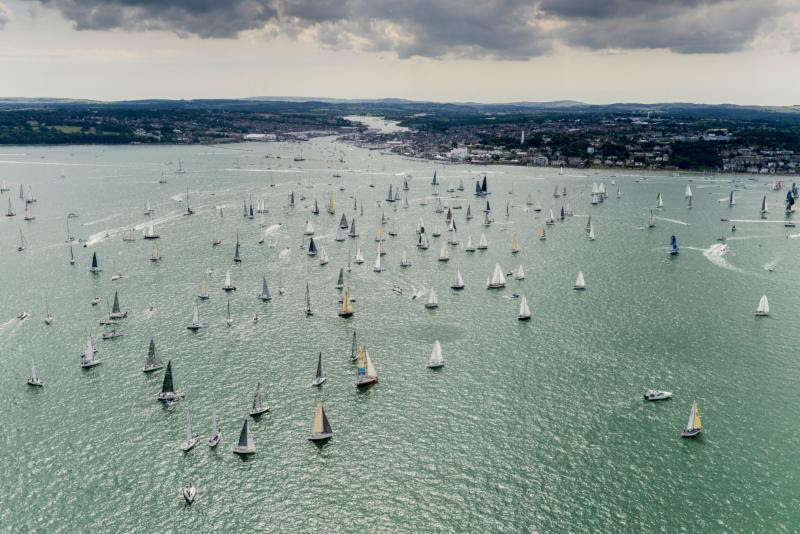
The record Rolex Fastnet Race fleet make their way out of the Solent 356 boats from 25 countries participated © Rolex/Kurt Arrigo
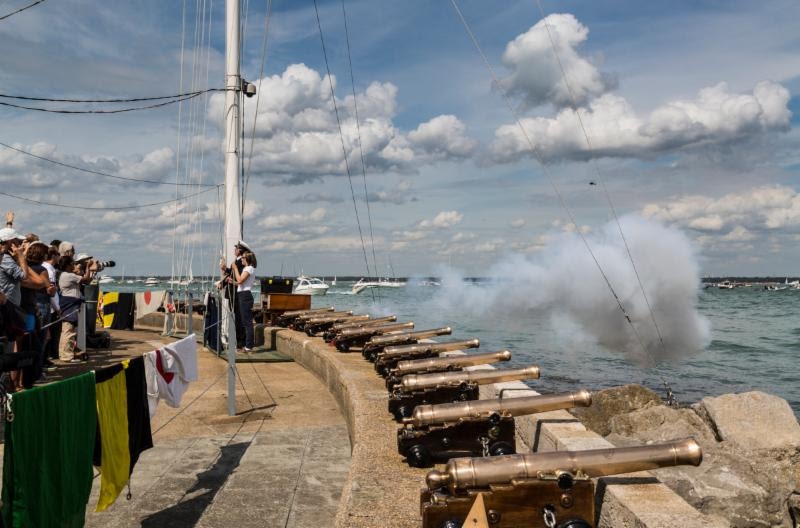
Cannons fired from the Royal Yacht Squadron in Cowes mark the start.The club is celebrating its bicentenary. © Rolex/Kurt Arrigo
Line honours
For the frontrunners the key moment came as the tide turned off the Lizard at Monday breakfast time. Here began the most giant of all yacht racing separations with the leading five multihulls and the top four monohulls getting away as those behind found the ‘door being closed’ on them.
The leaders – with Yann Guichard and Dona Bertarelli’s 40m trimaran Spindrift 2 ahead in the multihulls and Jim Clark and Kristy Hinze Clark’s 100ft Comanche in front among the monohulls – had a fast run up to the Fastnet Rock.
Both the monohull and multihull line honours races were remarkable for the clear-cut favourite being unable to shake off the boats chasing them, with Spindrift 2 on one occasion overtaken by two time Route du Rhum winner Lionel Lemonchois’ Prince de Bretagne, while Comanche had to employ covering tactics to keep George David’s persistent Rambler 88 at bay. Ultimately Spindrift 2 finished at 22:57:41 BST on Tuesday night, more than a day outside of her own record, with Lloyd Thornburg’s MOD 70 Phaedo³ second, two hours and 10 minutes later.
In the monohull race Rambler 88 and Mike Slade’s Leopard did well by following the multihulls to the south of the Scillies on their way out, while Comanche and Dieter Schon’s Maxi 72 Momo both lost out by going north. All four were then becalmed at different stages around the Fastnet Rock. As a result the monohull line honours battle ended up being close with Comanche finishing at 05:22:26 BST on Wednesday morning, just four and a half minutes ahead of Rambler 88. Of the front runners only Momo made any impression on handicap, the German Mini Maxi ultimately winning IRC Zero.
Comanche skipper Ken Read shared his take on the race: “It was honestly one of the most bizarre races I’ve ever been in in my life – starts and stops and people being left behind for dead and then all of a sudden they are sailing around you. It was phenomenal.”
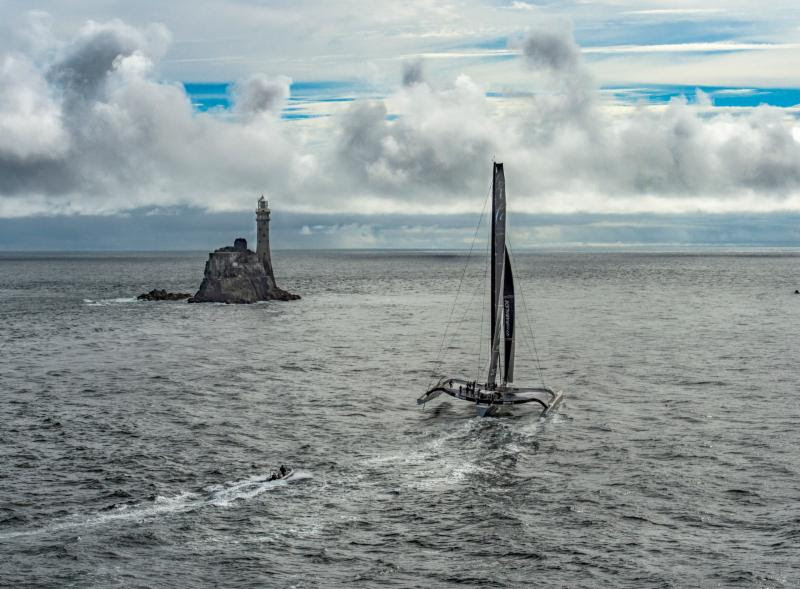
Line Honours winner: Yann Guichard and Dona Bertarelli’s 40m trimaran Spindrift 2 at the Fastnet Rock © Rolex/Kurt Arrigo
Maximum Pain
The boats in the wave behind the line honours contenders were those that finished in Plymouth having had the most ‘black and white’ race. The black part was being becalmed for more than a day between the Lizard and the Scilly Isles. In the windless high pressure zone here for example, Californian Peter Aschenbrenner’s 63ft trimaran Paradox covered just 15 miles in 10 hours. In the process this created a giant 130 mile Fastnet Rock to the Scillies-sized gap on the water between Momo and Paradox.
However Paradox made up for her light 24 hours with a blazing run between the Fastnet Rock and Plymouth, covering the 256 miles in just 13 hours and 51mins (compared to Spindrift 2’s 1 day 6 hours). This was enough to secure her the handicap prize in the MOCRA Multihull class.
While Paradox had led the bulk of the fleet up the west side of the TSS off Land’s End, another group had an equally benign time to the east of the TSS. This included the nine IMOCA 60s, the VO65 Team SCA and VO70 Camper. Here there was huge compression with boats like Ron O’Hanley’s Cookson 50 Privateer and the Carkeek 47 Black Pearl of German Stefan Jentzsch catching up the 60+ footers.
The breeze filled in for these groups on Tuesday morning and it was Paul Meilhat and two time Vendée Globe winner Michel Desjoyeaux on SMA that led the eastern group around the Fastnet Rock that evening, just 30 minutes behind Paradox.
Sailing doublehanded, the IMOCA 60s enjoyed a fast run back from the Rock but, proving that even the world’s best sailors are fallible, SMA missed a mark of the course – Bishop Rock, to the west of the Scilly Isles – and chose to retire. This handed IMOCA 60 victory to 2004 Vendée Globe winner Vincent Riou and America’s Cup helm Sebastien Col on board PRB. Despite being sailed fully crewed, the VO70 and VO65 arrived on the heels of the second IMOCA 60 – Yann Elies and Charlie Dalin’s Quéguiner-Leucémie Espoir.
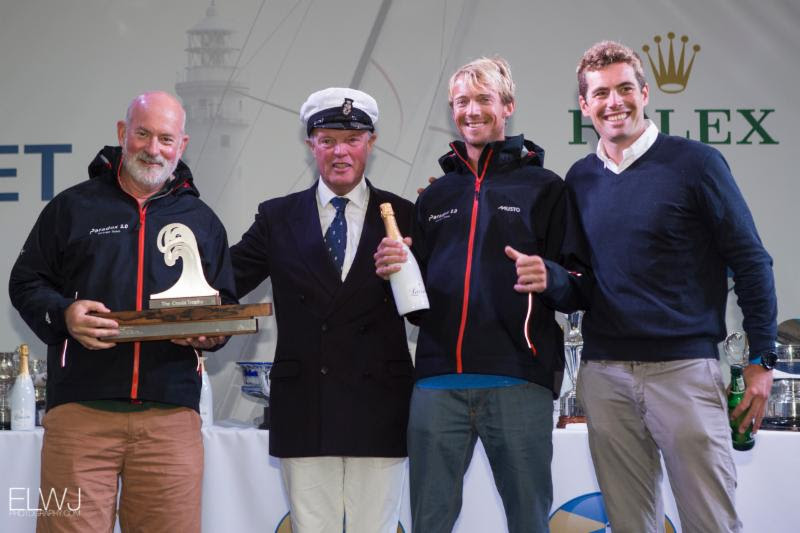
Peter Aschenbrenner’s 63ft trimaran Paradox secure handicap prize in MOCRA Mulithull Class© ELWJ Photography
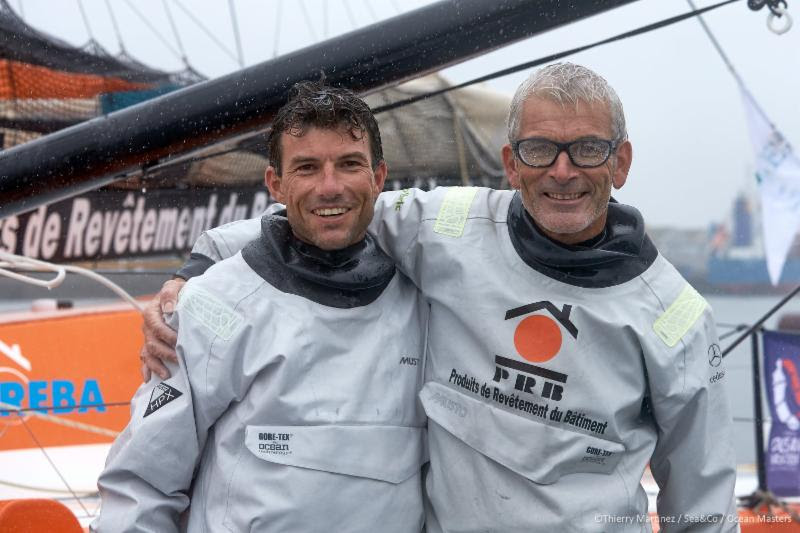
Victory for Vincent Riou and Sebastien Col on board IMOCA 60, PRB © Thierry Martinez/Sea&Co/Ocean Masters
IRC fleets – another French whitewash
Overall under IRC this year, France claimed seven of the top 10 spots and across the different IRC classes managed a near clean sweep: For a second race in a row, Nicolas Groleau’s Mach 45 Bretagne Telecom won IRC Canting Keel, her time correcting out just ahead of Privateer. IRC Zero was the only class where France didn’t perform – because they had almost no entries in it.
IRC 1 was won by Samuel Prietz’s Ker 39 GOA, her time correcting out to around 30 minutes ahead of South African Mike Bartholomew’s GP42 Tokoloshe II, in turn five minutes ahead of Eric De Turkheim’s mini VO70-like A13, Teasing Machine.
In IRC 2 there was a massive victory for the MC34, Nutmeg Solidaire En Peloton, skippered by 28 year old Corentin Lognone, winning by 2 hours and 22 minutes over her Belgium sistership, Vincent Willemart and Eric Van Campenhout’s Azawakh.
But even Nutmeg’s performance paled compared with that of Géry Trentesaux on his JPK 10.80, Courrier du Leon, which won IRC 3 on handicap – as well as the Rolex Fastnet Race overall. Courrier du Leon beat her IRC 3 adversaries on the water also and all of the larger IRC 2 boats as well.
France completed its massive export of silverware with former Transquadra winner Gerard Quenot claiming IRC 4 aboard his JPK 10.10, Alkaid III – Nautistock.com.
The only opportunity for Britain to come anyway close to maintained its pride in the face of this Gallic whitewash was with old hands Stuart Childerley and Kelvin Rawlings taking victory in the usually French-dominated Two Handed class and aboard their J/105 Jester. Here they beat 2013 Rolex Fastnet Race winning father and son, Pascal and Alexis Loison on their JPK 10.10 Night And Day into second by a mere 14 seconds! Childerley and Rawlings’ performance was such that Jester also ended up top British boat, finishing fourth overall under IRC.
With the exception of Jester, Concise 8 and former Caterham F1 CTO Mike Gascoigne’s Silvi Belle 2, second and third respectively in the Class40 to Gonzalo Botin’s Tales 2, British teams finished just off the podium elsewhere: Nick Jones’ First 44.7 Lisa fourth in IRC 1, Ross Applebey’s Scarlet Oyster fifth in IRC 2, while in IRC 4 Jonathan Rolls’ Swan SR38 Xara came fifth on corrected.
Generally the top spots overall in IRC were filled by boats from IRC 3 and 4, suggesting that the best vessel to suit this year’s weather was a well-sailed, fast, IRC-friendly small boat.
Tactically the most significant parts of the race for these boats was being able to shave the north side of the Casquets TSS on the first night and then hugging the Devonshire-Cornish coasts between Start Point and the Lizard. Importantly, boats in these classes generally managed to avoid the high pressure between the Scilly Isles and the Fastnet Rock and the resultant park-ups that affected the bigger, faster boats.
Triumphant Trentesaux
One of the most capped of all RORC sailors, Géry Trentesaux finally won the Rolex Fastnet Race on this, his 13th attempt, following his first attempt in 1977. The French sailor, who previously led France to Commodores’ Cup victory in 2006 and was part of their winning Admiral’s Cup team in 1991, this year sailed a JPK 10.80, the latest model from the French manufacturer based near Lorient, whose 10.10 model won the race overall in 2013.
Courrier Du Leon’s performance this year was all the more remarkable, after an uncharacteristic and costly error caused her to be over early at the start. In no wind and adverse tide it took her almost 40 minutes to return to recross the start line successfully. Despite this, the French team managed to gain the lead in IRC 3 on the water while passing the Lizard late on Monday evening. They then pulled ahead of all of IRC 2 amid the giant armada of boats setting off across the Celtic Sea to the Fastnet Rock.
Ultimately Courrier Du Leon won by 2 hours and 20 minutes over her sisterhip Arnaud Delamare and Eric Mordret’s Dream Pearls, which finished second both in IRC 3 and under IRC overall.
Aside from having a good boat, Trentesaux also had one of the best crews – Aubry Arnaud, Antoine Carpentier, Jean Louis Couedel, Francois Lamiot, Pierre Ghewy and Figaro sailor Jean Pierre Nicol. Five had sailed with him regularly since the 1999 Rolex Fastnet Race, while Lamiot has raced with Trentesaux ever since they both competed in the Figaro during the mid-1980s.
“I think we are very tough on the boat,” said Trentesaux. “If I ask them to hoist the spinnaker, then five minutes we take it down and five minutes we put it up – there are no questions…”
Of Trentesaux’s success Michael Boyd, Commodore of the Royal Ocean Racing Club said: “Géry is a fantastic winner. First of all he is a lovely man and he’s been a great RORC supporter for many years. All summer his has been the boat to watch. This is an amazing result – to win by two and a half hours is just extraordinary.”
Classic yawl dust-up
Within the Rolex Fastnet Race fleet there are many races within a race, especially between boats of the same design such as the J/109s and J/105s, First 40s and 40.7s, JPKs, Sigma 38s, etc. However a unique battle this year was between the classic S&S-designed yawls: Matt Brooks’ Dorade famously scored back to back Fastnet Race win in 1931 and 1933 while Christopher Spray’s Stormy Weather of Cowes won the race in 1935. They were joined by British comedian Griff Rhys Jones on his slightly larger and newer Argyll.
While Argyll lost contact with her rivals, Dorade and Stormy Weather rounded the Fastnet Rock together and then enacted a 250+ mile match race all the way to the finish. Ultimately Dorade came out on top with Stormy Weather arriving some 18 minutes behind her on corrected. As testament to how well the two boats were sailed, ( as well as IRC’s ability to create a level playing field between boats, regardless of their shape and size), they ultimately finished second and fourth in IRC 4 on corrected time and seventh and 11th overall under IRC.
“It was give and take; great competition; proper match racing,” said Matt Brook. “Second in class for a boat that is 85 years old is a great result, considering that the boat was last here in 1933.”
CEO comment
Royal Ocean Racing Club CEO Eddie Warden Owen observed of this year’s Rolex Fastnet Race: “I think it has been an incredibly challenging race – one of the best for a while. The teams that won had to work really hard. They had all conditions: Drifting, light winds up to strong winds – very challenging.
“This has been a very tough race to win and the French team that won overall deserved it. They have the miles and the results and they probably would tell you that they had a bit of luck, but I believe that they are good sailors and good sailors make luck for themselves.
“The French sail a lot at night, and probably do more offshore racing than we do and they are good at keeping their boats going.
“The Two Handed class impressed me: 68 boats, including the IMOCAs and the Figaros, shows that to be an area of sailing that is on the rise and it is an interesting discipline. The winners of the Two Handed class under IRC were two very good sailors – Stuart Childerley and Kelvin Rawlings – and to beat last year’s overall winners is a big achievement. You can believe that those two guys would have been grabbing every inch of performance out of their boat.”
The next Rolex Fastnet Race will take place in 2017.
Event details – Entry list – Results – Tracker
Report by James Boyd.
Background: The 603nm Rolex Fastnet Race is organised by the Royal Ocean Racing Club (RORC), with the 46th edition of the biennial race to start off the Royal Yacht Squadron line, Cowes, Isle of Wight on Sunday 16th August 2015. It is the largest offshore race in the world and attracts the most diverse fleet of yachts.


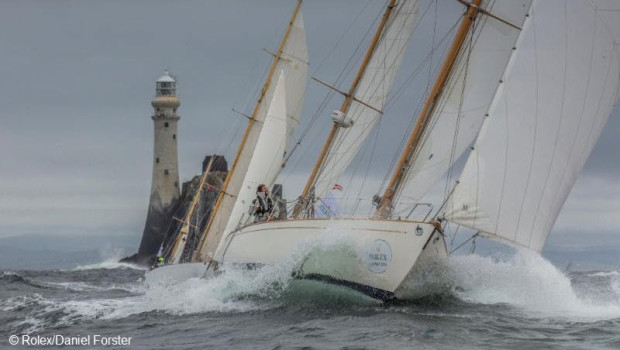

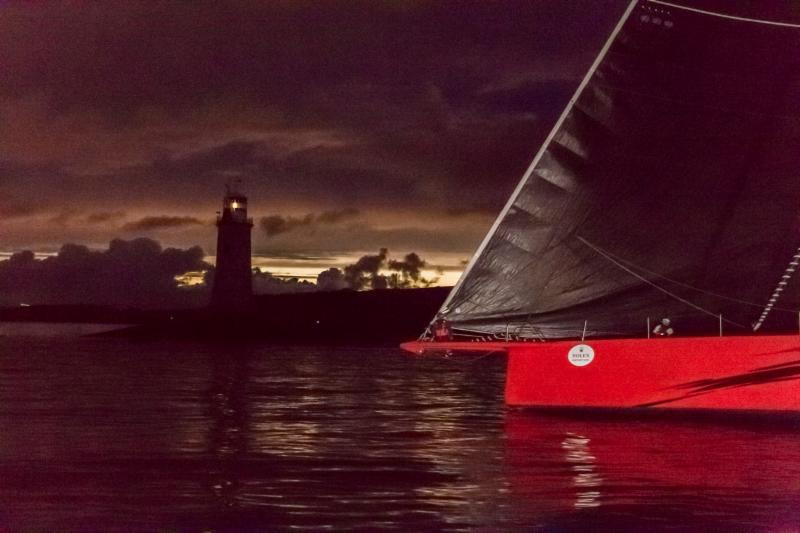
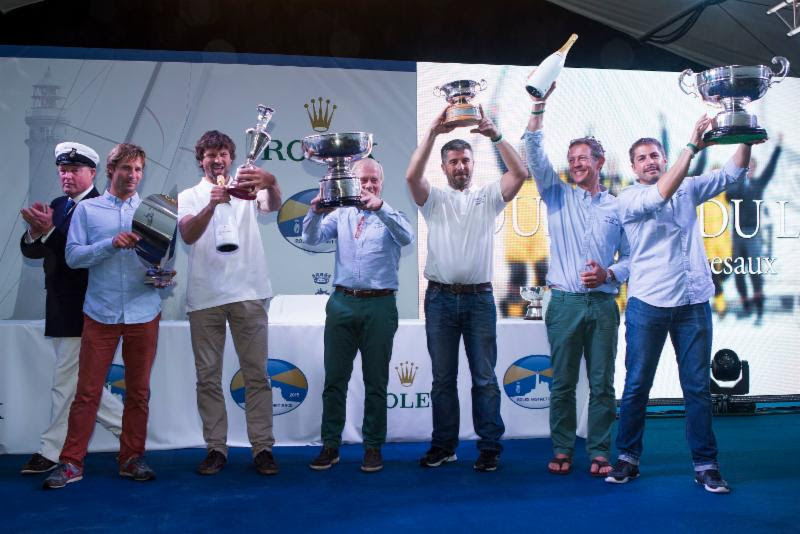
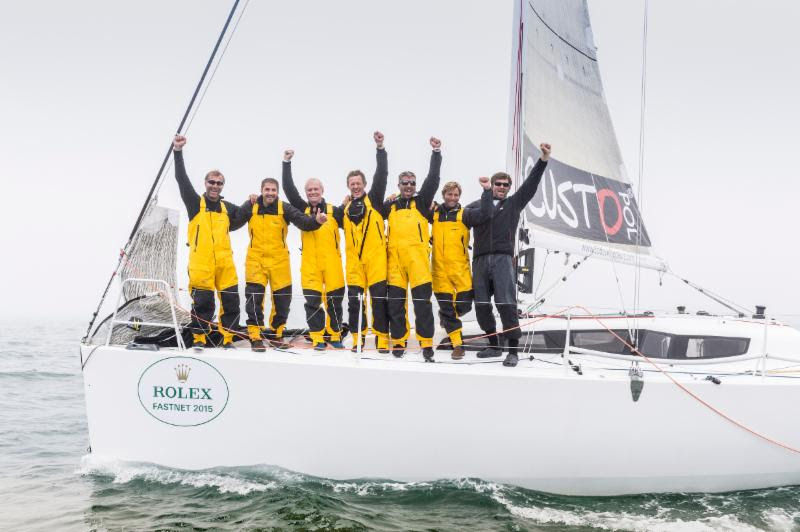
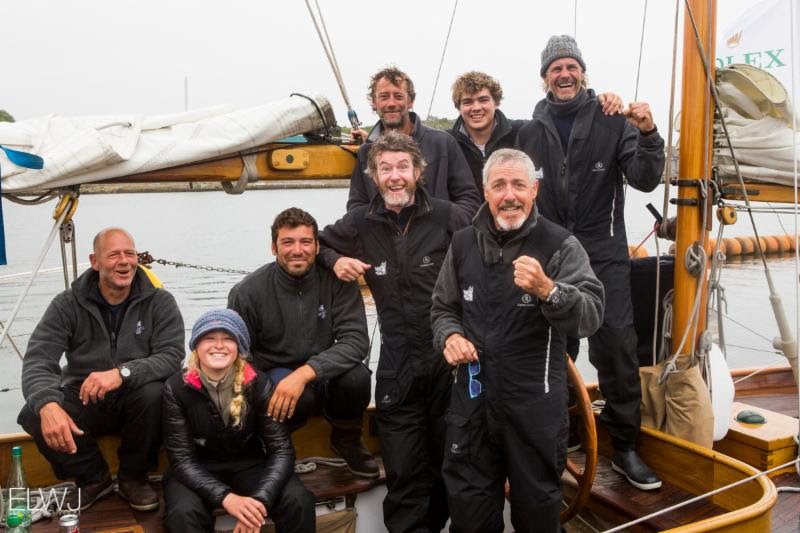
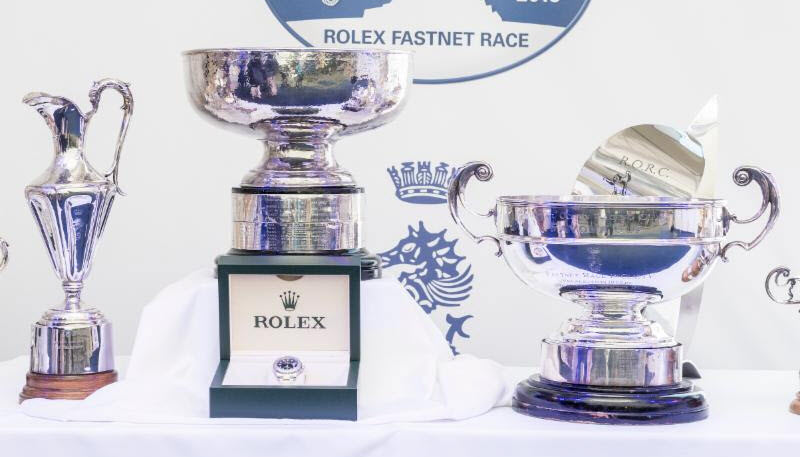
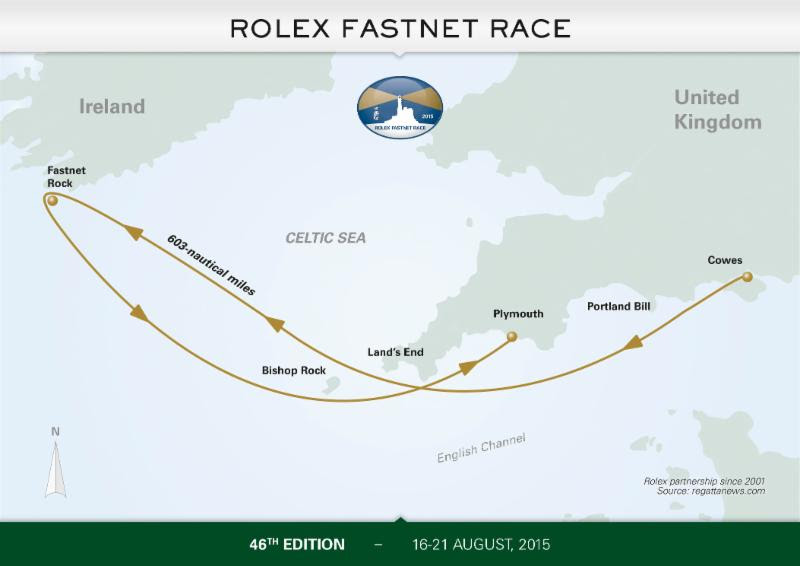


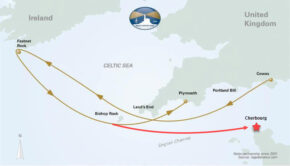
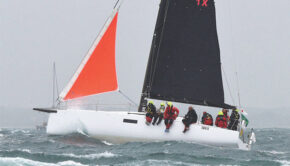
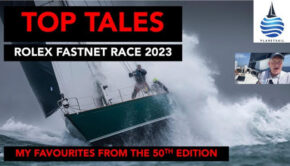
 We’ll keep your information safe.
We’ll keep your information safe.